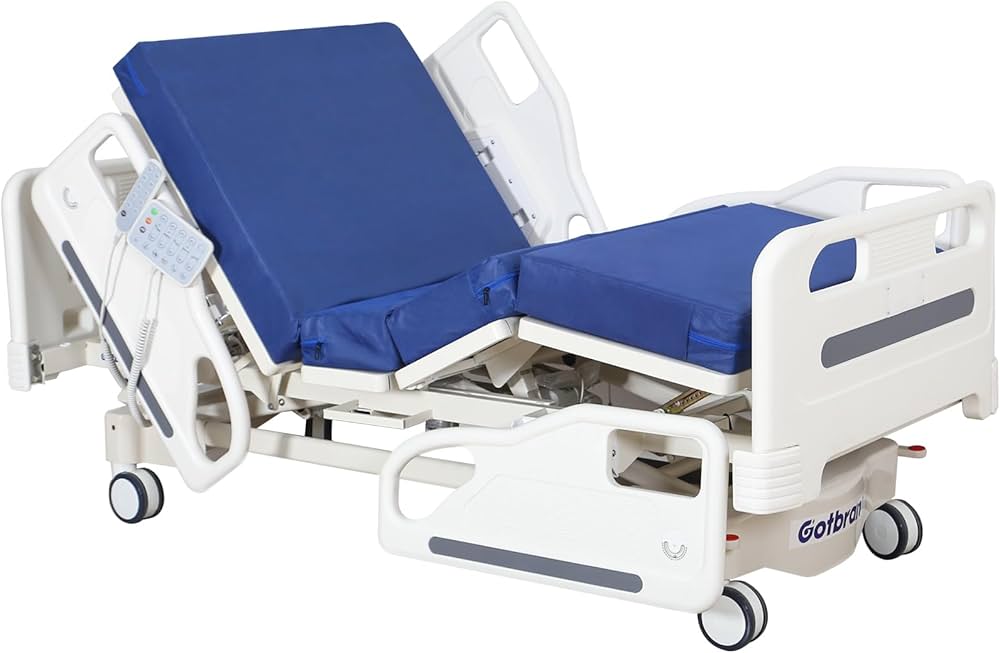Cama De Hospital Eléctrica De 7 Funciones De Alta Gama – A Complete Guide!
An electric hospital bed with 7 functions offers adjustable positions, Trendelenburg, reverse Trendelenburg, and anti-pressure relief, ideal for comfort, recovery, and circulation.
In this article, we will explore what an electric hospital bed with 7 functions is, its key features, advantages, and how to choose the best model for your needs. This detailed guide will help you understand the benefits and the functionality of these beds in various healthcare settings.
What is an Electric Hospital Bed with 7 Functions?

An electric hospital bed with 7 functions is a specialized bed equipped with electronic adjustments for patient comfort and care. Unlike manual beds, it uses motors to adjust the bed’s height, head, foot, and other positions easily. The “7 functions” refer to seven customizable settings, providing convenience and support. These beds are commonly used in hospitals, nursing homes, and home care environments for patients requiring extended care.
Key Features of the Electric Hospital Bed with 7 Functions:
The electric hospital bed with 7 functions is designed to provide maximum comfort, convenience, and functionality for both the patient and the medical staff. Below are the key features and functions that make these beds so popular in healthcare settings:
Height Adjustment:
The height adjustment function is one of the most important features of an electric hospital bed. This allows the bed to be raised or lowered to an ideal height, making it easier for patients to get in and out of bed. For healthcare providers, this feature is particularly useful because it helps prevent back strain and makes patient care more accessible. Adjusting the bed’s height can also improve circulation for patients by allowing them to rest in positions that encourage better blood flow.
Backrest Adjustment (Head Elevation):
The backrest adjustment or head elevation feature is essential for patients who need to remain in a semi-sitting position. Whether due to respiratory conditions, digestive issues, or recovery after surgery, the ability to elevate the head of the bed can improve comfort and provide better support. This function is particularly useful for patients with chronic conditions like acid reflux, sleep apnea, or breathing difficulties, as it helps keep their airways open and promotes easier breathing.
Leg rest Adjustment (Foot Elevation):
The leg rest adjustment function allows the foot of the bed to be raised, which is beneficial for patients suffering from circulatory problems, edema (swelling), or those recovering from surgery. Elevating the legs can help reduce swelling in the feet and legs, promote better circulation, and alleviate pain. This function also improves patient comfort by providing support for the lower body, especially for patients who experience discomfort from lying flat for extended periods.
Also read: Skip The Games Fort Wayne – Your Guide to Finding Local Connections!
Trendelenburg Position:
The Trendelenburg position is when the entire bed tilts so that the patient’s head is lowered and the feet are raised. This position can be useful in various medical situations, such as improving blood flow to the head or treating certain types of shock. In some cases, doctors may recommend this position for patients who are experiencing low blood pressure or other circulatory issues. It is also sometimes used during specific medical treatments or surgeries to optimize patient positioning.
Reverse Trendelenburg Position:
The reverse Trendelenburg position is the opposite of the traditional Trendelenburg. In this position, the head of the bed is raised while the foot section is lowered. This position is particularly helpful for patients with certain respiratory issues, like difficulty breathing or those suffering from certain gastrointestinal problems. By elevating the head and lowering the feet, the reverse Trendelenburg position helps relieve pressure on the diaphragm and promotes easier breathing.
Anti-Pressure Relief Features:

Modern high-end electric hospital beds come with anti-pressure relief features, which are essential for preventing the development of pressure sores (also known as bedsores) in patients who are bedridden or unable to move easily. These beds are equipped with adjustable mattress systems that provide support to different areas of the body, helping to relieve pressure and improve comfort. By preventing the formation of pressure ulcers, these beds enhance the patient’s overall recovery experience.
Nurse-Controlled and Patient-Controlled Settings:
Another major feature of electric hospital beds with 7 functions is the ability to control the settings both from the patient’s side and the nurse’s side. The bed typically comes with two types of controls: one for the patient to make minor adjustments independently and another for the medical staff to make larger, more detailed adjustments. This dual-control feature makes it easier for healthcare providers to make changes to the bed without disturbing the patient, while also allowing the patient to adjust their position for comfort.
Benefits of an Electric Hospital Bed with 7 Functions:
An electric hospital bed with 7 functions offers a wide range of benefits for both patients and healthcare providers. Below are some of the key advantages:
Improved Patient Comfort:
One of the most significant advantages of an electric hospital bed is the improved comfort it provides to the patient. With multiple adjustable positions, patients can easily find a position that alleviates discomfort or pain. Whether it’s elevating the head for better breathing, raising the feet to reduce swelling, or shifting the bed to an ergonomic position, these beds are designed to accommodate a variety of needs. This comfort is crucial for patients with chronic illnesses, post-surgery recovery, or those with mobility challenges.
Also read: Ravenswatch Game Trainer- The Role Of Game Trainers!
Ease of Use for Healthcare Providers:
Healthcare professionals benefit from the ease of use that comes with electric hospital beds. With the push of a button, medical staff can quickly adjust the bed to meet the patient’s needs, reducing physical strain on the staff and improving the efficiency of patient care. Additionally, the ability to adjust the bed’s height and position helps in performing medical procedures, conducting examinations, or providing treatments with minimal disruption to the patient.
Prevention of Pressure Ulcers:
Long-term bedridden patients are at risk of developing pressure ulcers (bedsores), which can complicate their recovery. Electric hospital beds with anti-pressure relief systems are designed to distribute pressure evenly across the body, reducing the risk of pressure sores. This is particularly beneficial for patients who are confined to bed for extended periods.
Better Circulation and Health Monitoring:

The various positions provided by these beds, such as the legrest and Trendelenburg functions, are not only designed for comfort but also for promoting better circulation. For patients with circulatory issues, such as those recovering from surgery or experiencing edema, raising the legs or adjusting the position can significantly enhance blood flow and reduce the risk of complications.
Convenience and Flexibility:
The flexibility and convenience offered by these beds are unmatched. Patients can adjust their position with ease, whether they need to sit up to eat, lie flat to sleep, or shift to a more comfortable posture. The patient can make simple adjustments without needing assistance, promoting greater independence. The nurse or caregiver can also easily adjust the bed as needed, improving the quality of care.
FAQ’s
1. What are the 7 functions of an electric hospital bed?
The 7 functions include height adjustment, backrest elevation, leg rest adjustment, Trendelenburg, reverse Trendelenburg, anti-pressure relief, and dual control settings for the patient and healthcare provider.
2. How does an electric hospital bed help with pressure ulcers?
Electric beds with anti-pressure relief features help distribute pressure evenly, preventing the formation of pressure ulcers, especially for bedridden patients.
3. Can patients adjust the electric hospital bed themselves?
Yes, patients can independently adjust the bed’s position using the controls, allowing them to find a comfortable posture without assistance.
4. What makes an electric hospital bed more convenient for healthcare providers?
The electric adjustment controls make it easy for healthcare providers to change the bed’s position quickly, reducing physical strain and improving patient care efficiency.
5. What should I consider when choosing an electric hospital bed?
Consider the bed’s adjustability, ease of operation, durability, safety features, and comfort to ensure it meets the patient’s specific medical and comfort needs.
Conclusion
An electric hospital bed with 7 functions provides excellent comfort and flexibility, ideal for long-term care and recovery. Its adjustable positions, including Trendelenburg and reverse Trendelenburg, along with anti-pressure relief features, enhance circulation and prevent complications. When selecting a model, it’s important to consider adjustability, ease of use, durability, and safety to meet both medical and comfort needs.







